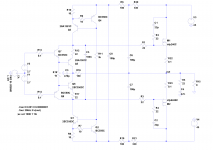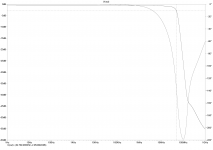Hi All,
Recently my amplifier designs have tended towards going for speed rather than complexity. This has led me to look at the output stage and try to design one that has speed as the main design goal.
The one presented here is a 2EF and uses Baxandall super pairs for the driver and Vertical MOSFETs for the output devices. The drivers are folded and use bootstrapping to allow the use of small fast transistors. Current sources are also bootstrapped again allowing the use of small fast transistors.
The idea is to present an easy load for the VAS to drive while using heavy biasing in the driver stage. The bootstrapping of the driver stage also means that Cob is kept constant.
The ft of this stage is about 50MHz.
Any comments welcome. 🙂
Many thanks,
Paul
Recently my amplifier designs have tended towards going for speed rather than complexity. This has led me to look at the output stage and try to design one that has speed as the main design goal.
The one presented here is a 2EF and uses Baxandall super pairs for the driver and Vertical MOSFETs for the output devices. The drivers are folded and use bootstrapping to allow the use of small fast transistors. Current sources are also bootstrapped again allowing the use of small fast transistors.
The idea is to present an easy load for the VAS to drive while using heavy biasing in the driver stage. The bootstrapping of the driver stage also means that Cob is kept constant.
The ft of this stage is about 50MHz.
Any comments welcome. 🙂
Many thanks,
Paul
Attachments
The one thing any seasoned audio designer will try to avoid is RF from the power amplifier. There is no usefulness to be gained from an amplifier that has a bandwidth above 30kHZ.
This is true but a fast output stage is useful when it comes to maximising feedback (ULGF)for a given set of stability conditions (PM/GM).
The one thing any seasoned audio designer will try to avoid is RF from the power amplifier. There is no usefulness to be gained from an amplifier that has a bandwidth above 30kHZ.
Must be very few seasoned designers left then.
Why waste energy amplifying unwanted harmonics that produce distortion and RF interference? There is no need to amplify Ultra Sonics unless you want the sound pressure on your ears to clean them out or scare dogs. One cannot hear it!
Not saying it isn't an achievement to get RF response from an audio amplifier.
The art of designing an audio HI FI top grade amplifier is to have LF and HF roll off set just below 25Hz and just above 18kHz with a flat response between audible frequencies only. One does not want below 22Hz as it is inaudible as is more than 18kHz.
Not saying it isn't an achievement to get RF response from an audio amplifier.
The art of designing an audio HI FI top grade amplifier is to have LF and HF roll off set just below 25Hz and just above 18kHz with a flat response between audible frequencies only. One does not want below 22Hz as it is inaudible as is more than 18kHz.
I can't really hear frequencies above 16khz very well but having a tweeter that goes to 30khz and an amp that supports it makes a difference in the temporal dynamics. If your amp or tweeter rolls of at 20khz it applies a low pass filter function into the response, which in the inverse Fourier domain, means that the signal will have a ringing impulse function. Having the ability to go beyond the audible band smooths this out and what you hear is cleaner smoother highs with less harshness. It's audible - just not in frequency but in time domain. I agree that RF band is not desirable to have interference but having the high speed means slew rate is high and that allows for cleaner and more distinct attack in transients. Percussive instruments sound better especially in transient perfect speakers.
Hi All,
Recently my amplifier designs have tended towards going for speed rather than complexity. This has led me to look at the output stage and try to design one that has speed as the main design goal.
The one presented here is a 2EF and uses Baxandall super pairs for the driver and Vertical MOSFETs for the output devices. The drivers are folded and use bootstrapping to allow the use of small fast transistors. Current sources are also bootstrapped again allowing the use of small fast transistors.
The idea is to present an easy load for the VAS to drive while using heavy biasing in the driver stage. The bootstrapping of the driver stage also means that Cob is kept constant.
The ft of this stage is about 50MHz.
Any comments welcome. 🙂
Many thanks,
Paul
Mcd99,
Interesting design. I like the simplicity and would be interested in seeing your simulated square wave response as well as distortion spectrum analyzer for 2khz sine and 10khz sine at full power.
I can't really hear frequencies above 16khz very well but having a tweeter that goes to 30khz and an amp that supports it makes a difference in the temporal dynamics. If your amp or tweeter rolls of at 20khz it applies a low pass filter function into the response, which in the inverse Fourier domain, means that the signal will have a ringing impulse function. Having the ability to go beyond the audible band smooths this out and what you hear is cleaner smoother highs with less harshness. It's audible - just not in frequency but in time domain. I agree that RF band is not desirable to have interference but having the high speed means slew rate is high and that allows for cleaner and more distinct attack in transients. Percussive instruments sound better especially in transient perfect speakers.


This is why I like to design a high slew rate amplifier.
You can compare the same amplifier with different compensation to make one have full power bandwidth about 30kHz and the other have full power bandwidth about 200kHz or more. Of course both amp must stable.
Why waste energy amplifying unwanted harmonics that produce distortion and RF interference? There is no need to amplify Ultra Sonics unless you want the sound pressure on your ears to clean them out or scare dogs. One cannot hear it!
Not saying it isn't an achievement to get RF response from an audio amplifier.
The art of designing an audio HI FI top grade amplifier is to have LF and HF roll off set just below 25Hz and just above 18kHz with a flat response between audible frequencies only. One does not want below 22Hz as it is inaudible as is more than 18kHz.
Well given sources have bandwidth of 50kHz you would have to point out your amplifier was not 'HD ready'. There are also movies out there with 16Hz content (and cathedral organ recordings) There are plenty of mega threads debating the benefits of running higher bandwidth. Worth checking them out. as there are some interesting engineering points made amongst all the golden ear claims.
It really does not matter if your OPS has >20mhz bandwidth if you are limiting
global with the input stage compensation.
In fact , it is better to have the faster output stage because it's signal is the
NFB source.
This is the main reason my more modern leach amp is 20ppm versus
the typical 70's .01-.02% (100-200ppm).
Also , if your typical "fast" input stage drives a slow output stage ....
cross-conduction and all sorts of other "bad behavior" arises.
All these current designs are 1/5 the THD 20K as opposed to the
70's-80's originals.
OEM THD specs really dropped after 1980 with the advent of >30mhz
fT power devices and >70mhz driver semi's.
OS
global with the input stage compensation.
In fact , it is better to have the faster output stage because it's signal is the
NFB source.
This is the main reason my more modern leach amp is 20ppm versus
the typical 70's .01-.02% (100-200ppm).
Also , if your typical "fast" input stage drives a slow output stage ....
cross-conduction and all sorts of other "bad behavior" arises.
All these current designs are 1/5 the THD 20K as opposed to the
70's-80's originals.
OEM THD specs really dropped after 1980 with the advent of >30mhz
fT power devices and >70mhz driver semi's.
OS
I would advise :
1- Checking that your MOSFET model has proper Cgd versus Vds
2- Check AC response with output 5V from rails, where Cgd becomes enormous
1- Checking that your MOSFET model has proper Cgd versus Vds
2- Check AC response with output 5V from rails, where Cgd becomes enormous
Hi Guys
It would seem sensible to have wide bandwidth in the output stage since the whole block has to be inserted into the feedback loop. The slow parts tend to bog things down and the gain to sacrifice at high frequencies dwindle fast, yielding kind of miserable THD20 like the Blameless has.
mcd99's output stage is interesting. Would it be beneficial to add a zener clamp to the bootstrapped caps?
Pete, I don't know where you are finding 20mHz Ft transistors. Even a 2N3772 has bandwidth to 800kHz. Maybe you mean 20MHz?
m=milli, 0.001
M=mega, 1,000,000
Have fun
It would seem sensible to have wide bandwidth in the output stage since the whole block has to be inserted into the feedback loop. The slow parts tend to bog things down and the gain to sacrifice at high frequencies dwindle fast, yielding kind of miserable THD20 like the Blameless has.
mcd99's output stage is interesting. Would it be beneficial to add a zener clamp to the bootstrapped caps?
Pete, I don't know where you are finding 20mHz Ft transistors. Even a 2N3772 has bandwidth to 800kHz. Maybe you mean 20MHz?
m=milli, 0.001
M=mega, 1,000,000
Have fun
- Status
- Not open for further replies.
- Home
- Amplifiers
- Solid State
- High Speed Output Stage Design

